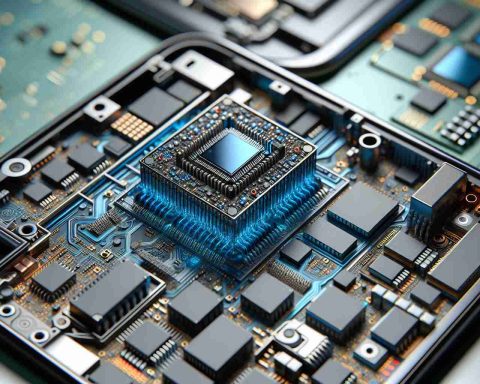South Korean stock markets took a notable downturn this Friday as major technology firms experienced significant losses. Investor anxiety heightened over the potential impact of U.S. President-elect Donald Trump’s proposed trade policies, which could include tariffs on South Korean exports to America. The Korea Composite Stock Price Index (Kospi) tumbled by 48.76 points, or 1.95%, landing at 2,455.91. Similarly, the Kosdaq index dropped by 16.2 points, reflecting a 2.33% decrease to end at 678.19.
In the realm of economic developments, South Korea’s industrial sector offered a glimmer of hope in October, demonstrating a promising recovery with a 2.3% year-on-year rise in the all-industry production index. This improvement comes after a decrease of 1.3% the previous month, as revealed by Statistics Korea on Friday. Nonetheless, the month-on-month figures showed a consistent decline of 0.3% for two consecutive months.
In a a brighter note for manufacturing, production gained 6.5% year-over-year in October, contrasting with a 1.5% decline observed in September, while marginal month-on-month growth of 0.4% was recorded.
In corporate news, Samsung Electronics announced a series of leadership changes. Young Hyun Jun, previously vice chairman and head of the device solutions division, takes on the role of co-CEO, leading the memory business and Samsung Advanced Institute of Technology. Promotions also included Jinman Han to president of the foundry business and Seok Woo Nam to chief technical officer. Despite these changes, Samsung Electronics’ stock closed down nearly 3% on Friday.
Surprising Economic Shifts and Leadership Overhauls: What’s Next for Global Markets?
When analyzing the swings in South Korean stock markets alongside corporate leadership dynamics, one finds an intricate web affecting not just South Korea, but rippling through global economic corridors. The recent downturn in South Korean stocks, with the Kospi and Kosdaq indices experiencing significant declines, points to larger, global economic anxieties. But beyond these numbers lies a trove of shifts and trends that carry broader implications for individuals, businesses, and nations.
The Trade Anxiety and Its Impact
One undercurrent of this downturn is the escalating tension over potential U.S. trade policies and tariffs targeting South Korean exports. Such policies, if implemented, could set off ripple effects through supply chains. South Korean technology and manufacturing sectors are heavily intertwined with global markets, notably the United States. A question arises: What could be the real impact of U.S. tariffs on South Korean exports?
For South Korean companies reliant on exports, these trade policies could mean increased costs and reduced competitiveness. On a larger scale, such economic policies may spur a reevaluation of trade alliances and could prompt South Korea to diversify its export markets, potentially strengthening ties with other Asian economies or the European Union.
Economic Resilience and Industrial Insights
Despite the turbulence in stock markets, there is a silver lining for South Korea’s industrial sector, which has shown resilience with increased production. The 2.3% rise in the all-industry production index signifies economic recovery post-pandemic. How do these indicators affect average citizens and communities? Economic resilience can benefit workers through job stability and potentially higher wages as demand increases.
Yet, the persistent, slight month-on-month declines suggest underlying instability. For communities reliant on specific industries, these fluctuations could mean uncertainty in employment, necessitating adaptive skills training and policy support to cushion potential negative impacts.
Leadership Changes at Samsung: A Corporate Evolution
The recent leadership shake-up at Samsung Electronics is another captivating narrative. Samsung, a global tech giant, influences not only South Korea’s economy but also global tech markets. The promotion of Young Hyun Jun and other leadership shifts spotlight Samsung’s strategic move towards innovation and future readiness. But what do these changes mean for consumers and competitors?
Such leadership overhauls can drive rapid advancements in technology, ushering in new products and services. For consumers, this may translate into improved technological offerings, yet for competitors, it could mean a more challenging market dynamic requiring accelerated innovation.
Advantages and Disadvantages
Advantages:
– Global interconnectedness could lead to diversified trade opportunities.
– Increased industrial production can boost economic growth and job creation.
– Leadership changes may spark innovation and drive technological progress.
Disadvantages:
– Trade policy uncertainties pose risks for export-reliant economies.
– Stock market volatility can affect investor sentiment and economic stability.
– Leadership transitions might create interim periods of instability within corporations.
Exploring Further
For those intrigued by these dynamics, delving deeper into trade policies, industrial growth statistics, and corporate leadership strategies can offer more comprehensive insights. Visit BBC and Financial Times for reliable global economic analyses and updates.
In the ever-evolving global marketplace, understanding the interplay between economic policies, industrial performance, and corporate leadership is crucial for navigating future challenges and capitalizing on emerging opportunities. As nations and corporations adapt to these changes, the coming years promise to be a period of innovation, adaptation, and strategic realignment.



















